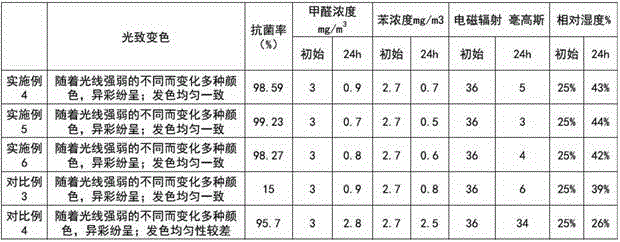Preparation method for anti-bacterial anti-radiation PLA (Poly Lactic Acid) material
A polylactic acid material and radiation protection technology, applied in the field of composite materials, can solve the problems of inability to distribute uniformly, difficult to meet multi-function, and product performance decline, and achieve the purpose of adding emotional and artistic effects, expanding the scope of application, and improving stability. Effect
- Summary
- Abstract
- Description
- Claims
- Application Information
AI Technical Summary
Problems solved by technology
Method used
Image
Examples
Embodiment 1
[0028] A kind of preparation method of antibacterial composite material, it comprises the following steps:
[0029] (1) Preparation of graphene quantum dot suspension: weigh 0.5g of C60 powder, measure 50ml of concentrated sulfuric acid with a mass fraction of 98%, mix C60 powder and concentrated sulfuric acid in a beaker, place the beaker in an ice-water bath, and simultaneously Stir at a speed of 500rpm to obtain a mixed solution; weigh 3g of potassium permanganate powder, and slowly add it to the above mixed solution; remove the ice-water bath and replace it with a water bath, keep the temperature of the water bath at 30~40°C, and react for 8 hours; quickly add 200ml of pure Water, filtered, and then dialyzed for 3 days with a dialysis bag with a molecular weight cut-off of 1000 to obtain a suspension of graphene quantum dots; the suspension of graphene quantum dots was stirred at a speed of 100 rpm, while laser irradiation was performed for 30 minutes, and the laser irradia...
Embodiment 2
[0038] A kind of preparation method of antibacterial composite material, it comprises the following steps:
[0039] (1) Preparation of graphene quantum dot suspension: Weigh 0.7g of C60 powder, measure 80ml of concentrated sulfuric acid with a mass fraction of 98%, mix C60 powder and concentrated sulfuric acid in a beaker, place the beaker in an ice-water bath, and simultaneously Stir at a speed of 500rpm to obtain a mixed solution; weigh 2g of potassium permanganate powder, and slowly add it to the above mixed solution; remove the ice-water bath and replace it with a water bath, keep the temperature of the water bath at 30-40°C, and react for 6 hours; quickly add 200ml of pure Water, filtered, and then dialyzed for 3 days with a dialysis bag with a molecular weight cut-off of 1000 to obtain a suspension of graphene quantum dots; the suspension of graphene quantum dots was stirred at a speed of 100 rpm, while laser irradiation was performed for 45 minutes, and the laser irradia...
Embodiment 3
[0048] A kind of preparation method of antibacterial composite material, it comprises the following steps:
[0049] (1) Preparation of graphene quantum dot suspension: Weigh 0.8g of C60 powder, measure 100ml of concentrated sulfuric acid with a mass fraction of 98%, mix C60 powder and concentrated sulfuric acid in a beaker, put the beaker in an ice-water bath, and simultaneously Stir at a speed of 500rpm to obtain a mixed solution; weigh 1g of potassium permanganate powder, and slowly add it to the above mixed solution; remove the ice-water bath and replace it with a water bath, keep the temperature of the water bath at 30-40°C, and react for 5 hours; quickly add 100ml of pure Water, filtered, and then dialyzed for 3 days with a dialysis bag with a molecular weight cut-off of 1000 to obtain a suspension of graphene quantum dots; the suspension of graphene quantum dots was stirred at a speed of 100 rpm, while laser irradiation was performed for 60 minutes, and the laser irradiat...
PUM
 Login to View More
Login to View More Abstract
Description
Claims
Application Information
 Login to View More
Login to View More - R&D
- Intellectual Property
- Life Sciences
- Materials
- Tech Scout
- Unparalleled Data Quality
- Higher Quality Content
- 60% Fewer Hallucinations
Browse by: Latest US Patents, China's latest patents, Technical Efficacy Thesaurus, Application Domain, Technology Topic, Popular Technical Reports.
© 2025 PatSnap. All rights reserved.Legal|Privacy policy|Modern Slavery Act Transparency Statement|Sitemap|About US| Contact US: help@patsnap.com



